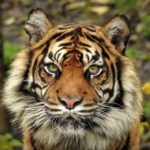While global attention is currently focused on COVID-19, a disease that has jumped from animals to humans, it is important to remember that diseases that breach the species barrier also pass from people and their domestic animals to wildlife populations. And this poses a serious threat to endangered species like tigers who are already teetering on the brink of extinction.
The first episode in the Year of the Tiger series of WildCats Pawast covers the top three infectious diseases which are having an impact on tigers, including the indirect threats from African Swine Fever and Lumpy Skin Disease to the more direct impacts of Canine Distemper Virus.
One undeniable common theme between all three diseases is that the human disruption of natural systems is intensifying unnatural interactions between species and creating emerging infectious disease transmission pathways. But not only are we engaging in our natural environment in a more exploitative way, but we are also traversing it differently. The movement of people, animals and animal products has increased dramatically through international travel and trade which has effectively meant that diseases benefit from more freedom of movement than most of the human population.
Listen to the episode below
In this blog we take a deep dive into Lumpy Skin Disease (LSD)
Tim Redford, Freeland Foundation’s Surviving Together Program Director, has been living and working in Thailand for the last 22 years contending with a cocktail of threats to tigers. The Surviving Together Program is an integrated conservation development project based in Thailand involving park protection, community outreach, wildlife monitoring and human-wildlife conflict (HWC) resolution. Tim has first-hand experience with Lumpy Skin Disease which has been emerging in the landscapes he is working in within South East Asia.
Tim explained that LSD is a disease that affects cattle and first emerged from Africa about 100 years ago. Since then it has spread across Europe, the Middle East and finally into southeast Asia. It has only been recorded in Thailand since 2020 so it is even newer to that landscape than COVID-19.

The vectors for LSD are biting flys, mosquitos and ticks which are quite common in tropical forests such as those found in South East Asia. As cattle are illegally grazed inside forested protected areas (PAs) they get bitten by these blood-sucking insects which are transmitting the diseases. It also spreads easily from one cow to another through a variety of bodily fluids. So on top of the ecological disturbance which comes from illegally grazing cattle in PAs, there is also now a pandemic potential as the domestic and wild cattle mingle and spread LSD. Since LSD was first recorded in Thailand in 2020 it has moved rapidly throughout the whole country with national parks now recording outbreaks in key tiger prey species.
So far, LSD has only a 10% mortality rate in infected cattle, but it does depress them for several months meaning they become easy prey for animals such as tigers and leopards. We are also seeing this impact in wild species too meaning that prey numbers will swiftly fall. Additionally, as domestic cattle become easier prey large carnivores become ever more tempted which closes the gap between people and tigers and inevitably leads to more human-tiger conflict.


But what is being done to control Lumpy Skin Disease?
One solution is the removal of all illegal grazing cattle from protected areas. Tim Redford is extremely enthusiastic about this plan as cattle create a lot of ecological disturbance in the form of noise pollution and habitat destruction. He believes that if LSD does act as a motivator to finally put an end to illegal grazing in national parks in Thailand then it could in fact be of benefit to tigers and other large carnivores as it allows for more wild prey species to inhabit these landscapes.
But how is this going to be actioned? the challenge of illegal grazing in protected areas in Thailand is huge spanning the whole country. The process would involve monitoring the cattle in the parks to try and find out where they are, how many of them there are and who they belong to. This is difficult as they are not often owned by local residents but instead by large commercial farmers. Tim believes there would have to be a national policy in place to implement this and parks would have to enforce a slow phase-out of the cattle. But, protected areas in Thailand and all across the world are struggling for finance as government resources have been reallocated to covid mitigation. Removal of illegal grazers would have been a difficult task in normal circumstances, but in the wake of a global pandemic, we are yet to see if the necessary action will be taken.



